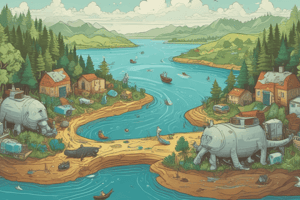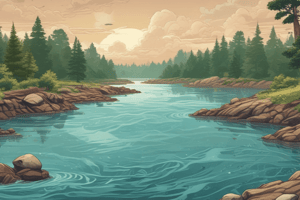Podcast
Questions and Answers
Which of the following scenarios best illustrates how the water cycle contributes to water pollution?
Which of the following scenarios best illustrates how the water cycle contributes to water pollution?
- Industrial factories release heated water directly into rivers, disrupting aquatic ecosystems.
- Acid rain, formed from atmospheric pollutants, falls into lakes, increasing their acidity.
- Runoff from agricultural fields carries pesticides into rivers, contaminating water sources. (correct)
- Untreated sewage is dumped into the ocean, leading to algal blooms and dead zones.
A town relies on a river for its drinking water. After a heavy storm, the water becomes muddy and contains high levels of bacteria. What is the most likely cause of this pollution?
A town relies on a river for its drinking water. After a heavy storm, the water becomes muddy and contains high levels of bacteria. What is the most likely cause of this pollution?
- Erosion and runoff from nearby farms and construction sites have contaminated the river. (correct)
- A nearby factory has illegally discharged wastewater into the river.
- The town's water treatment plant has malfunctioned due to a power outage.
- Increased volcanic activity has altered the river's chemistry.
A scientist discovers that a local lake has unusually high concentrations of mercury in its fish. Which of the following human activities is the LEAST likely source of this pollution?
A scientist discovers that a local lake has unusually high concentrations of mercury in its fish. Which of the following human activities is the LEAST likely source of this pollution?
- Improper disposal of batteries and electronic waste.
- Runoff from agricultural fields using phosphate fertilizers. (correct)
- Industrial processes that use mercury.
- Emissions from coal-fired power plants.
A community wants to reduce its impact on local water resources. Which of the following strategies would be MOST effective in achieving this goal?
A community wants to reduce its impact on local water resources. Which of the following strategies would be MOST effective in achieving this goal?
How can technology improvements and efficiency contribute to both water conservation and pollution reduction?
How can technology improvements and efficiency contribute to both water conservation and pollution reduction?
Flashcards
Water Pollution
Water Pollution
Adding harmful substances to clean water sources.
Causes of Water Pollution
Causes of Water Pollution
Farming, industrial waste, dumping trash, and untreated sewage.
Pollution via Water Cycle
Pollution via Water Cycle
Rainwater flows, dissolves, and carries pollutants from land to water bodies.
Effects of Water Pollution
Effects of Water Pollution
Signup and view all the flashcards
Water Resource Management
Water Resource Management
Signup and view all the flashcards
Study Notes
- Over 70% of Earth is covered by water, primarily salt water, and water is essential for life.
- Water pollution is the introduction of harmful substances into clean water sources.
- Water pollution damages living organisms, land, and other resources.
Causes of Water Pollution
- Most water pollution results from human activities, including farming, industrial waste, trash dumping, and untreated sewage.
- Farming contributes through the use of pesticides and herbicides.
How Pollution Enters Water
- Pollutants enter the water cycle when rainwater, known as runoff, dissolves and carries materials from land to streams, rivers, lakes, groundwater, or the ocean.
- Erosion carries and deposits polluted sediments into new areas, rivers, and oceans.
Effects of Water Pollution
- Water pollution harms living things by causing diseases.
- Habitats for aquatic organisms are destroyed; for example, water can become too acidic, killing off certain species.
- Fish and seafood can become toxic and dangerous for consumption.
- Soil can become difficult to farm as pollutants seep into the ground.
Water Resource Management
- Monitoring water quality involves measuring, analyzing samples, and identifying pollutants.
- Managing water includes preventing and reducing water pollutants through methods like cleaning oil spills, sewage treatment, and regulating factories and farms.
- Water conservation means careful use and protection of Earth's water supply, including restricting use when necessary.
- Technological improvements can help prevent and clean up water pollution.
- More efficient use of water, such as water-saving appliances and drip irrigation, helps conserve water resources.
Studying That Suits You
Use AI to generate personalized quizzes and flashcards to suit your learning preferences.
Description
Water pollution occurs when harmful substances contaminate clean water sources, largely due to human activities like farming and industrial waste. Pollutants enter the water cycle through rainwater runoff and erosion. This pollution leads to diseases, habitat destruction, and contamination of seafood, harming both ecosystems and human health.




